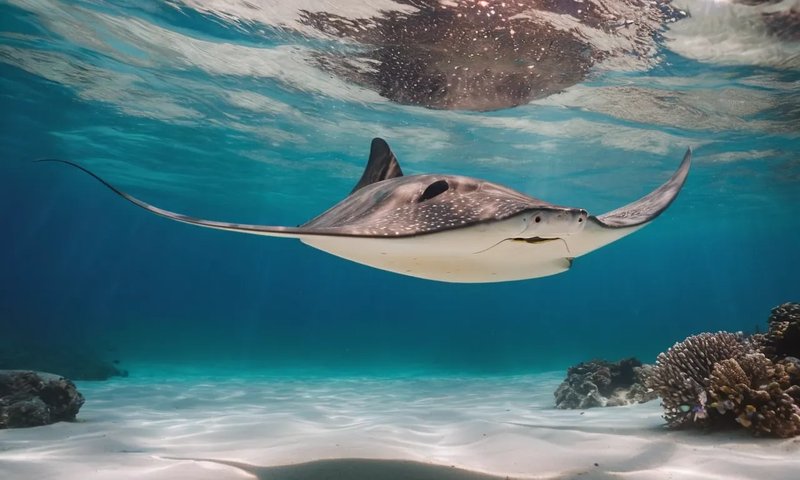
Stingrays are often seen as misunderstood creatures. Many people fear them, thinking of their barbed tails as dangerous weapons, while others admire them for their elegance and grace. For those who’ve had the chance to swim with stingrays, the experience can be thrilling—like dancing underwater with a gentle giant. Yet, despite their enchanting nature, cultural legends and superstitions have created a mix of curiosity and caution around them.
In this blog, we’re going to explore various myths surrounding stingrays, cultural beliefs that have shaped perceptions, and the truth behind these graceful ocean dwellers.
The Stingray in Ancient Cultures
Stingrays have long been a part of human culture. In ancient civilizations, they were often revered as symbols of power and mystery. For instance, the indigenous peoples of the Americas viewed stingrays as creatures that bridged the gap between land and sea. They believed that these animals possessed a kind of spiritual significance, guiding souls in their journey to the afterlife.
In some areas, stingrays were seen as protectors. The way they glide silently through the water reminded people to move gracefully through life, avoiding unnecessary conflict. This notion speaks to a deeper understanding of nature’s balance—where every creature has its role, and the stingray plays a significant part in keeping the ecosystem healthy.
On the flip side, some myths painted them as omens. Fishermen feared encountering stingrays, believing that their presence signaled turbulent waters or impending storms. This fear often stemmed from the stingray’s ability to camouflage itself on the ocean floor, making it easy for fishermen to unknowingly come too close. The unexpected sting could lead to an injury that was seen as a punishment by the sea.
Cultural Beliefs and Modern Interpretations
As cultures evolved, so did the beliefs surrounding stingrays. In Polynesian culture, stingrays are often associated with the goddess of the ocean, and their presence is thought to bring good luck to fishermen. In this light, seeing a stingray while out at sea is considered a blessing. Fishermen often tell stories of how they’ve had successful catches after encountering these creatures, reinforcing their revered status.
In contrast, some coastal communities have developed a more cautious attitude toward stingrays. They warn swimmers of the potential dangers and recommend “stinging ray shuffle” as a safety measure when walking in shallow waters. The shuffle is a technique where you shuffle your feet along the sandy bottom to alert any lurking stingrays of your presence. This blend of respect and caution reflects the complex relationship humans have with nature.
Stingrays have also made their way into modern media and pop culture, often depicted as menacing creatures in movies and documentaries. This portrayal, while captivating, can overshadow their gentle nature. The truth is, stingrays are typically shy and peaceful unless provoked. It’s important for people to understand that these creatures are not out for revenge but are simply trying to navigate their environment—much like us.
Myths vs. Reality: The Stingray’s Defense Mechanisms
One of the most persistent myths about stingrays is that they aggressively attack anyone who comes near them. This couldn’t be further from the truth. Stingrays prefer to avoid confrontation and will only use their barbed tails as a last resort when they feel threatened. It’s essential to remember that, just like any wild animal, they have their way of defending themselves.
Their sting can indeed be painful, but it’s often not life-threatening to humans. Most injuries happen when people accidentally step on them while wading through shallow waters. The best way to enjoy stingrays and avoid injuries is to learn about their behavior and to be mindful when visiting their habitats.
Many coastal aquariums and marine parks offer the chance to interact with stingrays in a safe environment. Here, you can watch how they glide effortlessly through the water and even touch them in designated areas. These experiences can help break down myths and build a more accurate understanding of these creatures.
Stingrays in Folklore and Storytelling
Various cultures have woven stingrays into their folklore, giving them mythical statuses. In certain African tribes, stingrays are seen as symbols of adaptability, reflecting their ability to thrive in diverse marine environments. Stories passed down through generations often depict these creatures as wise guides, teaching humans to be resilient and resourceful.
In some Caribbean cultures, stingrays are memorialized in dance and art. They inspire stories that highlight community values, such as harmony with nature and the importance of respecting marine life. These tales often serve as lessons for younger generations, promoting a sense of respect and admiration for the ocean.
Interestingly, some cultures also associate stingrays with love. In Hawaiian culture, for instance, they symbolize fidelity and devotion, making their image a popular choice in jewelry and tattoos. This association with love highlights how deeply intertwined stingrays are with human emotions and relationships.
The Role of Stingrays in Marine Ecosystems
Beyond myth and legend, stingrays play a vital role in the health of marine ecosystems. They help maintain the balance of ocean life, feeding on small fish, crustaceans, and mollusks. By controlling these populations, stingrays contribute to the greater health of coral reefs and ocean environments.
Stingrays have a unique feeding behavior known as “suction feeding.” They use their mouths to suck in prey from the sandy ocean floor. This not only showcases their intriguing feeding habits but also emphasizes their ecological importance—keeping marine life balanced.
However, stingrays face threats from overfishing, habitat loss, and environmental changes. Raising awareness about their importance and the myths surrounding them can help protect these magnificent creatures and their habitats. Community programs and conservation efforts are crucial in ensuring the survival of stingrays for future generations.
As we’ve explored, stingrays are surrounded by fascinating myths and beliefs that reflect humanity’s complex relationship with nature. From ancient cultures that viewed them as spiritual guides to modern misconceptions that paint them as dangers, the stingray continues to captivate our imagination.
Understanding the reality behind these myths not only enriches our appreciation for stingrays, but also fosters respect for their role in our oceans. So next time you’re by the water, take a moment to reflect on the grace of stingrays, and perhaps you’ll see them as more than just creatures with a sting. Instead, consider them as part of the intricate tapestry of life in our oceans—mysterious, beautiful, and truly worthy of admiration.

